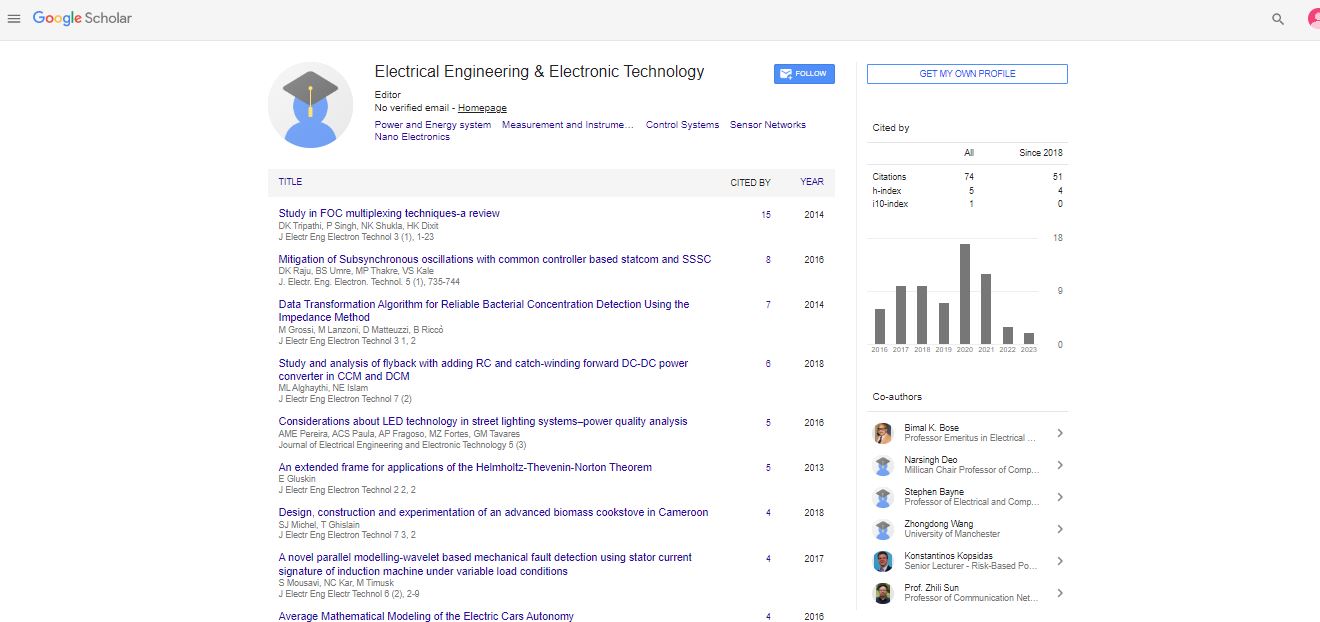Editorial, J Electr Eng Electron Technol Vol: 14 Issue: 1
Grid Integration: Connecting the Future of Energy
Anna Grandas*
Department of Microelectronics, University of Navarra, Spain
- *Corresponding Author:
- Anna Grandas
Department of Microelectronics, University of Navarra, Spain
E-mail: ana937@gmail.com
Received: 01-Jan-2025, Manuscript No. jeeet-25-170060; Editor assigned: 4-Jan-2025, Pre-QC No. jeeet-25-170060 (PQ); Reviewed: 18-Jan-2025, QC No. jeeet-25-170060; Revised: 25-Jan-2025, Manuscript No. jeeet-25-170060 (R); Published: 30-Jan-2025, DOI: 10.4172/2325-9838.1000991
Citation: Anna G (2025) Grid Integration: Connecting the Future of Energy. J Electr Eng Electron Technol 14: 991
Introduction
Grid integration refers to the process of incorporating various energy sources, especially renewable energy systems, into the existing electrical power grid. As the world shifts toward cleaner energy sources like solar, wind, and hydro, the traditional power grid—originally designed for centralized, predictable power generation—is being challenged to accommodate the variability and decentralization brought by these new technologies [1]. Effective grid integration is critical for maintaining the stability, reliability, and efficiency of power systems while enabling the transition to a sustainable energy future.
Discussion
The traditional electrical grid was designed around large, centralized power plants using fossil fuels or nuclear energy, which produce steady and controllable electricity. In contrast, renewable energy sources like solar and wind are inherently variable and intermittent. For example, solar power depends on sunlight, which fluctuates daily and seasonally, while wind speeds can be unpredictable. This variability presents significant challenges to grid operators, who must continuously balance supply and demand to prevent outages or damage [2].
Grid integration involves several technical, operational, and regulatory strategies to manage these challenges. One key technology is smart grid systems, which use advanced sensors, communication networks, and automation to monitor and control electricity flow in real-time. Smart grids allow for better forecasting of renewable generation, dynamic adjustment of loads, and rapid response to disturbances, making the grid more flexible and resilient [3].
Energy storage systems, such as batteries and pumped hydro storage, also play a vital role in grid integration. They store excess energy generated during periods of high renewable output and release it when generation drops or demand rises, smoothing out fluctuations and enhancing grid stability. Additionally, demand response programs encourage consumers to adjust their energy use based on grid conditions, further aiding balance [4].
Another aspect of grid integration is the interconnection standards and protocols that ensure renewable energy systems can safely and reliably connect to the grid. These standards govern how equipment behaves during faults, voltage fluctuations, and other grid events to prevent instability or damage.
The increasing penetration of distributed energy resources (DERs) such as rooftop solar panels, electric vehicles, and home energy storage complicates grid management. While DERs provide benefits like reduced transmission losses and increased local generation, they also introduce two-way power flows and require sophisticated control systems [5].
Successful grid integration also depends on regulatory frameworks that incentivize investments in infrastructure upgrades, storage technologies, and grid management tools. Policies encouraging open access, fair pricing, and research in grid modernization help accelerate the transition.
Conclusion
Grid integration is essential for enabling a sustainable and reliable energy future. By effectively incorporating renewable energy and distributed resources into the power grid, grid integration enhances flexibility, reliability, and efficiency. While the challenges of variability, control, and infrastructure modernization are significant, advances in smart grid technology, energy storage, and regulatory support provide powerful solutions. As renewable energy continues to grow worldwide, effective grid integration will be the cornerstone that allows societies to meet their energy needs while reducing environmental impact and ensuring a resilient electricity supply.
REFERENCES
- Eigenbrode SD (2007). Employing philosophical dialogue in collaborative science. Bioscience. 57: 55-64.
- Fiksel J (2014). The triple value model: a systems approach to sustainable solutions Clean Technol. Environ Policy. 16: 691-702.
- Glika DC (2007). Risk communication for public health emergencies. Annu Rev Public Health. 28: 33-54.
- Hoover E (2015). Social science collaboration with environmental health Environ. Health Perspect. 123: 1100-1106.
- Maxwell K (2014). Getting there from here Nat. Clim Chang. 4: 936-937.
Indexed at, Google scholar, Cross ref
Indexed at, Google scholar, Cross ref
Indexed at, Google scholar, Cross ref
 Spanish
Spanish  Chinese
Chinese  Russian
Russian  German
German  French
French  Japanese
Japanese  Portuguese
Portuguese  Hindi
Hindi 
